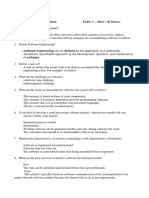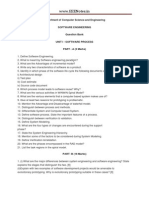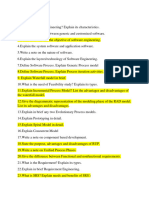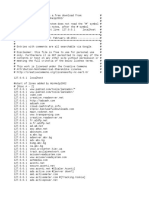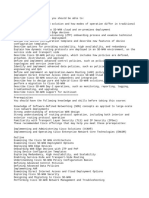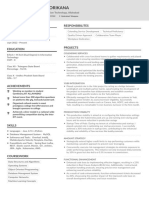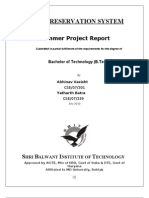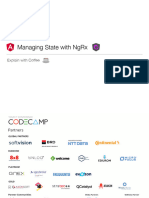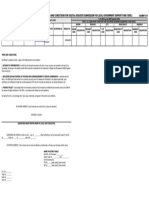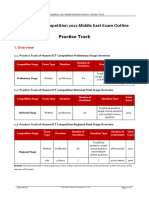Software Engineering Assignment Questions
UNIT I :
1. What are the key models and methodologies for managing software evolution, and how do they
compare to traditional software development models?
2. What are some common challenges in managing software development projects, and how can they be
overcome?
3. How does exploratory software development support continuous delivery? Explain how rapid iterations,
frequent releases, and constant user feedback help teams refine and improve software on an ongoing basis.
What are the Benefits and Challenges of Exploratory Style Software Development?
4. What role did the development of the Software Development Life Cycle (SDLC) play in the emergence
of Software Engineering? How did the introduction of life cycle models (e.g., Waterfall, V-Model)
improve software development practices?
5. Discuss the importance of data communication and networking in computer system engineering. What
are the different types of communication protocols, and how do they ensure effective data transfer across
systems? Also, Write the Applications, Challenges of Computer System Engineering.
6. Explain the Waterfall Model in detail. How does it compare to other software life cycle models? What
are the advantages and limitations of the Waterfall Model?
7. Explain the term 'risk-driven' in the context of the Spiral Model. How does the Spiral Model help in
mitigating risks throughout the software development process?
8. Explain the concept of prototyping in RAD. How is prototyping different from traditional development
models like the Waterfall Model? What are the advantages and disadvantages of prototyping in RAD?
9. Explain the Agile Model and its principles. How does Agile address the limitations of traditional
software life cycle models? What are the different frameworks under Agile, such as Scrum, and how do
they function?
10. How does the Spiral Model support the long-term sustainability and maintainability of a software
product?
�UNIT II :
1. How do you manage the complexity of defining and maintaining the project scope throughout the
software development lifecycle?
2. What are the key responsibilities of a software project manager during the initial planning phase of
a software project?
3. What are the key quantitative and qualitative metrics used in project size estimation, and how do
they contribute to accurate forecasting of project effort, cost, and duration?
4. Briefly explain project size estimation using Delphi and expert judgement techniques. Compare the
advantages and disadvantages of the following two project size estimation techniques—expert
judgement and Delphi technique.
5. How do empirical estimation techniques apply to agile and iterative development methodologies,
and what modifications are necessary to ensure their effectiveness in dynamic project
environments?
6. What are the different categories of software development projects according to the COCOMO
estimation model? Give an example of software product development projects belonging to each of
these categories.
7. How can Halstead’s Software Science be leveraged in modern automated code analysis tools, and
what enhancements are needed to make these metrics more relevant in today’s large-scale and AI-
driven software development environments?
8. What are the key principles of risk management, and how do they contribute to identifying,
assessing, mitigating, and monitoring risks in large-scale projects across different industries?
9. What are the goals of the requirements analysis and specification phase? How are the requirements
analysis and specification activities carried out and by whom?
10. Discuss the important ways in which a well formulated SRS document can be useful to various
stakeholders.
11. What is the difference between the functional and the non-functional requirements of a system?
Identify at least two functional requirements of a bank automated teller machine (ATM) system.
Also identify one non-functional requirement for an ATM system.
12. What are the key principles and advantages of formal system specification, and how does it
improve the reliability, correctness, and maintainability of complex software systems?
13. What are the fundamental principles of axiomatic specification in software engineering, and how
does it differ from other formal specification techniques such as algebraic and model-based
specifications?
14. How does algebraic specification support modularity and reusability in software development, and
what are the best practices for structuring complex systems using algebraic techniques?
15. What role does executable specification play in agile and model-driven software development
methodologies, and how can it be effectively integrated into iterative development processes?
�16. What are the defining characteristics of fourth-generation languages (4GLs), and how do they
differ from third-generation languages (3GLs) and other high-level programming paradigms?
17. How does the use of 4GLs influence software maintenance and long-term support, and what
challenges arise when migrating legacy 4GL-based systems to modern architectures?
�UNIT III :
1. What are the SOLID principles in software design? Explain each principle with real-world examples.
2. How can you define a good software design? What key characteristics should it have?
3. How does a layered architecture improve software maintainability and scalability? What are the main
characteristics of a well-structured layered software system?
4. What is the relationship between cohesion and coupling in software design? How does unit testing and
test-driven development (TDD) help enforce good cohesion and coupling principles?
5. What are the major approaches to software design? List and briefly describe several prominent
approaches (e.g., top-down, bottom-up, data-driven, object-oriented, aspect-oriented).
6. How does agility address the cost of change? Explain how agile methodologies aim to minimize the
negative impact of changing requirements or unforeseen issues.
7. How does CI/CD relate to Agile? How does it support frequent releases and rapid feedback?
8. What is Extreme Programming (XP), and how does it differ from other Agile methodologies like
Scrum or Kanban?
9. What are some popular Agile project management tools, and how do they support different aspects of
Agile development?
10. What is the importance of data flow diagrams (DFD) in function-oriented design?
11. What are the core concepts of SA/SD? Explain concepts like data flow diagrams (DFDs), structure
charts, data dictionary, and process specifications.
12. What are the key components of structured analysis, and how do they contribute to the design process?
13. How does the level of abstraction change as you move from Level 0 to deeper levels in the DFD?
14. How does Structured Design relate to Structured Analysis? How does the output of Structured
Analysis (DFDs) inform the Structured Design process?
15. How do you ensure the quality of the detailed design? What techniques are used for design review and
validation?
16. What is the typical format of a detailed design review meeting? Describe the flow of the meeting and
the roles of the participants.
17. Determine about user interface design methodology with the help of an architecture and an example.
18. Discuss principles like clarity, consistency, simplicity, efficiency, feedback, and error prevention.
19. What are the characteristics of a good user interface? Explain in detail.
20. Explain about all types of user interfaces with the help of an architecture and an example.
21. What are the fundamentals of component-based GUI development? Explain in detail with a diagram
and an architecture.
22. Determine about user interface design methodology with the help of an example.
�UNIT IV :
1. How does version control (e.g., Git) enhance the coding and collaboration process? Explain
concepts like branching, merging, and resolving conflicts with practical examples.
2. What is Continuous Integration (CI) and Continuous Deployment (CD)? How do these practices
improve software testing and development?
3. How does Object-Oriented Programming (OOP) differ from Functional and Procedural
Programming? Discuss key OOP principles such as encapsulation, inheritance, polymorphism, and
abstraction with code examples.
4. What is the purpose of a code review, and how does it contribute to software quality? Discuss the
key benefits of code reviews, such as improved code quality, knowledge sharing, and defect
detection. Provide real-world examples.
5. How does software documentation contribute to knowledge management within an organization?
Explain how documentation prevents knowledge loss and helps new developers onboard quickly.
6. What are the different types of software testing (Unit Testing, Integration Testing, System Testing,
Regression Testing, etc.)? Explain their purpose, key differences, and when each type should be
performed in the software development lifecycle.
7. What is Black-Box Testing, and how does it differ from White-Box and Gray-Box Testing?
Provide real-world examples and discuss the advantages and limitations of each approach.
8. Why is White-Box Testing important in software development? Discuss its role in detecting
security vulnerabilities, logic errors, and performance issues.
9. What is debugging, and why is it an essential part of software development? Explain the different
stages of debugging and how developers can systematically identify and fix errors in code.
10. What are program analysis tools, and why are they important in software development? Discuss
their role in improving code quality, debugging, performance optimization, and security.
11. What are the key challenges faced during Integration Testing? Discuss issues like data
inconsistencies, module dependencies, and environment configuration, along with solutions to
overcome them.
12. What is class testing in object-oriented programming? How does it differ from function-level
testing in procedural programming? Explain with examples.
13. Explain the step-by-step process of performing Smoke Testing. How do testers decide which test
cases should be included in a smoke test suite?
14. How do incomplete or ambiguous software requirements affect the testing process? What
strategies can testers use to handle unclear specifications and ensure comprehensive testing?
�15. What is software reliability, and why is it a critical aspect of software engineering? Discuss the
factors that impact software reliability and how it differs from software availability and
maintainability.
16. What is statistical testing, and why is it important in data analysis and scientific research? Discuss
the fundamental concepts, including hypotheses, significance levels, and p-values.
17. What is software quality, and why is it important in software development? Discuss the key
characteristics of high-quality software, such as reliability, maintainability, and security.
18. What is Software Quality Management (SQM), and why is it important in software development?
Discuss the key components of an effective SQMS and how they contribute to high-quality
software products.
19. What is ISO 9000, and why is it important in software development and quality management?
Discuss its principles, objectives, and benefits for organizations.
20. What are the key roles in a Six Sigma project? Describe the responsibilities of Six Sigma
professionals, including Green Belts, Black Belts, and Master Black Belts.
�UNIT V :
1. What is Computer-Aided Software Engineering (CASE), and how does it impact the software
development life cycle (SDLC)? Discuss the advantages and limitations of CASE tools in modern
software development.
2. How do CASE tools assist in database design and development? Explain how they are used for
schema generation, normalization, and database maintenance.
3. What is the scope of CASE tools in large-scale enterprise software development? Discuss their
impact on complex software projects and their integration with other development tools.
4. What is a CASE environment, and why is it important in modern software development? Explain
the role of CASE tools in improving software quality, efficiency, and maintainability.
5. Compare traditional software development approaches with CASE-supported development. What
are the advantages and disadvantages of using CASE tools in software projects?
6. How do CASE tools support the Requirements Analysis phase? Explain how tools like IBM
Rational RequisitePro and Enterprise Architect help in requirement gathering and management.
7. How do CASE tools support Model-Driven Development (MDD)? Explain with examples how
they help in system modeling, UML diagram generation, and code generation.
8. How have second-generation CASE tools impacted software development methodologies such as
Agile and DevOps? Explain with case studies or examples.
9. Discuss the core components of a CASE architecture, including the repository, user interface, and
integration framework. How do these components enable efficient software development?
10. What is software maintenance, and why is it important in the software development lifecycle?
Explain the role of maintenance in ensuring software reliability and performance over time.
11. What are the key characteristics of software maintenance? Explain factors such as longevity, cost-
effectiveness, impact on software quality, and technical debt.
12. What are the different stages of reverse engineering? Explain the key steps, including disassembly,
decompilation, static and dynamic analysis, and documentation.
13. What are the major factors that influence the cost of software maintenance? How can organizations
reduce maintenance costs while ensuring software quality?
14. How does the complexity of a software system impact its maintenance cost? Discuss factors such
as code quality, dependencies, and documentation in cost estimation.
15. Explain the different levels of software reuse, such as code reuse, module reuse, component reuse,
and system reuse. How do these levels contribute to efficient software development?
16. Why is code or component reuse still not widely adopted in software development, despite its
known benefits? Discuss the technical, organizational, and cultural barriers that prevent reuse.
17. What is software reuse, and why is it important in modern software development? Discuss the
different levels of reuse (code reuse, component reuse, architecture reuse) and their benefits.
18. How does modular programming support software reuse? Discuss the principles of modular
design, separation of concerns, and dependency management.
19. What does "reuse at the organizational level" mean in software development and business
processes? Discuss its significance, benefits, and challenges.
20. What role does open-source software play in organizational reuse strategies? Discuss the benefits
and risks of using open-source libraries and frameworks.








































